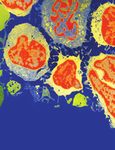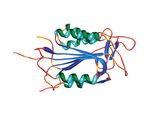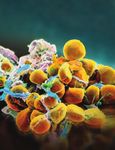Case Report Aneurysms of Pancreaticoduodenal Artery due to Median Arcuate Ligament Syndrome, Treated by Open Surgery and Laparoscopic Surgery
←
→
Page content transcription
If your browser does not render page correctly, please read the page content below
Hindawi
Case Reports in Surgery
Volume 2019, Article ID 1795653, 4 pages
https://doi.org/10.1155/2019/1795653
Case Report
Aneurysms of Pancreaticoduodenal Artery due to Median
Arcuate Ligament Syndrome, Treated by Open Surgery and
Laparoscopic Surgery
Satoshi Tokuda , Shunsuke Sakuraba , Hajime Orita , Mutsumi Sakurada,
Tomoyuki Kushida , Hiroshi Maekawa , and Koichi Sato
Department of Surgery, Juntendo Shizuoka Hospital, Shizuoka, Japan
Correspondence should be addressed to Satoshi Tokuda; stokuda@juntendo.ac.jp
Received 2 October 2018; Accepted 13 December 2018; Published 13 January 2019
Academic Editor: Christophoros Foroulis
Copyright © 2019 Satoshi Tokuda et al. This is an open access article distributed under the Creative Commons Attribution License,
which permits unrestricted use, distribution, and reproduction in any medium, provided the original work is properly cited.
Introduction. There are many possible causes of an abdominal visceral aneurysm, including the obstruction of the celiac artery by
the median arcuate ligament (MAL). We report two cases of an aneurysm of the pancreaticoduodenal artery due to MAL syndrome
that we treated surgically. Case Presentation. Case 1: a 66-year-old Japanese woman was diagnosed with a rupture of an aneurysm of
the inferior pancreaticoduodenal artery. Because of the difficulty of endovascular therapy, we performed an emergency operation.
We chose an abdominal operation, and the postoperative course was uneventful. Case 2: a 75-year-old Japanese man presented at
our hospital with acute abdominal pain, nausea, and cold sweat. Our experience of treating MAL syndrome in case 1 enabled us to
diagnose the disease accurately. We chose laparoscopic surgery, and the postoperative course was uneventful. Discussion. There are
several treatment choices for an aneurysm of the pancreaticoduodenal artery due to MAL syndrome. We have performed only a
release of the MAL for treatment, but it is difficult to conclude whether only releasing the MAL is enough to ensure a positive
long-term prognosis. Regular follow-up is needed in such cases. Conclusion. Laparoscopic surgery can be considered one of the
options for MAL syndrome.
1. Introduction postprandial abdominal pain, epigastric bruit, and weight
loss [2].
Abdominal visceral aneurysms are rare, accounting for The first reports of MAL syndrome were by Harjola in
approx. 1% of all aneurysms. It was reported that 60% 1963 and Dunbar in 1965 [3]. MAL syndrome occurs in 2
of abdominal visceral aneurysms occur in a splenic artery, per 10,000 patients [4] and is more common in young people
20% in a hepatic artery, 10% in the superior mesenteric and thin women. The lower level of the MAL (especially
artery, and 2% in the pancreaticoduodenal artery [1]. A during expiration) or the upper level of the celiac artery
ruptured abdominal visceral aneurysm has a poor progno- (or both) can cause MAL syndrome, which can have nonspe-
sis; the mortality rates are 25% for a splenic artery, 35% cific symptoms, making the diagnosis difficult. A rupture of
for a hepatic artery, and 50% for a pancreaticoduodenal an aneurysm sometimes reveals MAL syndrome.
artery. There are several possible causes of an aneurysm Here, we report two cases in which an aneurysm of the
of a pancreaticoduodenal artery: arteriosclerosis, pancreati- pancreaticoduodenal artery due to MAL syndrome was
tis, trauma, fibromuscular dysplasia, segmental arterial treated successfully by surgery. The first patient underwent
mediolysis, and stenosis or obstruction of the celiac artery a laparotomy, and the other patient underwent laparoscopic
by the median arcuate ligament (MAL). The MAL is in surgery. The usefulness of laparoscopic surgery has been
front of the aortic hiatus, and “MAL syndrome” occurs reported, including descriptions of more rapid clinical
when the root of the celiac artery is compressed by the improvement, less complications, quick recovery, and a good
MAL. The clinical features of MAL syndrome are chronic cosmetic outcome [5].2 Case Reports in Surgery
2. Case 1
Case 1 was a 66-year-old Japanese woman who had pre-
sented at another hospital with acute abdominal pain which
she experienced when she took a bath before she was rushed
to the hospital. Her vital signs indicated shock (systolic blood
pressure was 70 mmHg), and her CT scan showed intraperi-
toneal bleeding. She was transferred to our hospital. She had
no notable medical history. On admission, her body temper-
ature was 37.4°C and her pulse was 118 bpm/min.
After fluid resuscitation, the patient’s blood pressure
was 129/94. Laboratory findings showed slight leukocytosis
(15,600/μl) and anemia (9.9 g/dl). A CT scan revealed a
great volume of ascites and an aneurysm (Figure 1). The
angioarchitectonic examination showed the aneurysm of
the inferior pancreaticoduodenal artery (IPDA) and stric-
ture of a root of the celiac artery (Figure 2). We then per- Figure 1: Case 1: a 66-year-old woman, CT scan showing a large
formed angiography (Figure 3), which also showed the amount of ascites and an aneurysm.
aneurysm of the IPDA. We attempted coil embolization,
but because of the difficulty inserting the catheter, we aborted
the embolization and decided to perform surgery instead. We
had no prior experience with MAL syndrome, and in light of
the emergency, we chose an abdominal operation.
We conducted an abdominal median section and could
see the intra-abdominal hemorrhage. Excessive bleeding
was observed in the retroperitoneum around the duodenum,
pancreas, and transverse colon. The IPDA, which is the vas-
cular arcade of the inferior margin of the pancreas, had a Figure 2: Case 1: the angioarchitectonic revealed the aneurysm of
10 mm aneurysm. We confirmed the aneurysm’s existence the inferior pancreaticoduodenal artery (IPDA; arrowhead) and
by perioperative sonography, ligated the feeder, and removed stricture of a root of the celiac artery (arrows).
the aneurysm.
For the prevention of a rerupture of the aneurysm, we
attempted to resect the MAL. After taping the left gastric
artery, we observed that the celiac artery was covered by the
MAL. We cut the MAL away little by little and confirmed
the increase of the beating of the left gastric artery. After
placing drainage tubes in the left subphrenic area and
the inferior side of pancreas, we closed the wound of the
abdominal incision. The operation time was 4 hours 27
minutes, and the blood loss was 1800 ml. The patient began
to take hospital meals on postoperative day 8. The postoper-
ative course was uneventful, and she was discharged on the
22nd hospital day. CT scans have shown no recurrence of
the aneurysm for 3 years.
3. Case 2 Figure 3: Case 1: angiogram showing an aneurysm of the IPDA.
Case 2 was a 75-year-old Japanese man who presented at our
hospital with acute abdominal pain, nausea, and cold sweat. MAL syndrome and the benefits of this surgery. The patient’s
His CT scan showed retroperitoneal bleeding (around the posture for the surgery was the lithotomy position.
pancreas and the dorsal side of the ascending colon). His gen- Intra-abdominal pressure of 12 mmHg was maintained.
eral condition was stable, but he was admitted to our hospital The points of the trocars were as follows: a 12 mm trocar at
as a conservative measure. His angiography (6 days after the navel for the camera, two 12 mm trocars at the right
admission) showed an aneurysm of the pancreaticoduodenal upper abdomen, and a 12 mm trocar and a 5 mm trocar at
artery without active bleeding. the left upper abdomen (Figure 5).
Our experience treating MAL syndrome in case 1 enabled First, we lifted the liver umbilical ligament by surgical
us to diagnose the disease accurately in case 2. MAL syn- sutures and put in an organ retractor to the crus of the
drome was the cause of the aneurysm in this patient too diaphragm in order to improve the field of vision. After
(Figure 4). We selected laparoscopic surgery based on the opening the omental bursa, we lifted the stomach with aCase Reports in Surgery 3
decrease, the blood flow of the superior mesenteric artery is
increased, as is the flow of the IPDA. The IPDA is not very
thick, and it cannot bear much blood flow.
However, the precise mechanism underlying MAL syn-
drome is unclear [6]. The MAL should be considered in the
cases of patients for whom a pancreaticoduodenectomy
(PD) is planned. In a PD, a compressed celiac artery is the
cause of a serious hepatobiliary complication because of the
resection of the pancreaticoduodenal arcades. MAL is found
in approx. 10% of preoperative CT examinations of patients
for whom a PD is planned [7].
There are several choices of treatment for an aneurysm
of a pancreaticoduodenal artery due to MAL syndrome:
surgery (open, laparoscopic, or robot-assisted [8, 9]), stent-
ing for the celiac trunk, and coil embolization for the
Figure 4: Case 2: the CT scan shows stricture of a root of the celiac aneurysm. In case 1, the difficulty of inserting the catheter
artery by MAL (arrow). for the pancreaticoduodenal artery prevented treatment by
an endovascular procedure. Surgeons must therefore be
prepared to perform an emergency operation at any time
for the treatment of an aneurysm.
The first description of laparoscopic surgery for MAL
syndrome was published in 2000 [10]. Since then, several
studies have addressed the advantage of laparoscopic man-
agement of MAL syndrome: rapid clinical improvement,
less complications, quick recovery, decreased rate of postop-
erative adhesions, and a good cosmetic outcome [4–11].
However, there are negative aspects of laparoscopic surgery.
In 9.1% of a laparoscopic group, open conversion was neces-
sary because of bleeding [4]. Depending on the situation, a
laparotomy procedure is necessary for the treatment of
Camera trocar MAL syndrome.
12mm trocar In our two patients, we performed only a release of the
5mm trocar MAL as treatment, and there has been no recurrence of the
Figure 5: The trocar placement for the laparoscopic surgery for case
aneurysms. Other studies described stenting the vessels with
2, a 75-year-old man. operation and angioplasty to prevent recurrence [5, 12, 13].
Because of the relatively short periods of time since the sur-
gery in our patients (2 and 3 years), it is too soon to conclude
snake retractor and observed the dorsal side of the stom- that only the release of the MAL was enough for a good
ach. We confirmed the left gastric artery and tied it with long-term prognosis. In case 2, we checked the improvement
tape. The tape was taken out from the right outside trocar, of the blood flow of the left gastric artery. If this improvement
and an assistant pulled it to provide traction of the surgi- had not been confirmed, a reconstruction of the celiac artery
cal field. Following the celiac artery to the root, the artery might have been necessary. Regular follow-up is needed in
was fastened by the MAL. We cut the MAL away little by similar cases.
little with a vessel-sealing system until the running direction
of the celiac artery was clearly confirmed. Using a blood flow
meter, we confirmed the improvement of blood flow of the 5. Conclusion
left gastric artery (from 5 mm/min to 69 mm/min). A drain- Based on our experience, laparoscopic surgery for MAL syn-
age tube was placed in the left subphrenic area, and the drome can be considered a good choice. Surgeons should
wound of the abdominal incision was closed. The operation become familiar with the pathophysiology of MAL syndrome
time was 3 hours 35 minutes, and the blood loss was minimal and its appropriate treatment.
at 15 ml. The patient’s CT scans have shown no recurrence of
the aneurysm for 2 years.
Conflicts of Interest
4. Discussion The authors declare no conflict of interest.
One of the mechanisms of the formation of an aneurysm of References
the IPDA by MAL syndrome is as follows. (1) The celiac
artery is compressed by the MAL, (2) the blood flow to the [1] J. C. Stanley, T. W. Wakefield, L. M. Graham, W. M. White-
liver or spleen is decreased, and (3) to compensate for this house Jr., G. B. Zelenock, and S. M. Lindenauer, “Clinical4 Case Reports in Surgery
importance and management of splanchnic artery aneu-
rysms,” Journal of Vascular Surgery, vol. 3, no. 5, pp. 836–
840, 1986.
[2] K. M. Horton, M. A. Talamini, and E. K. Fishman, “Median
arcuate ligament syndrome: evaluation with CT angiography,”
RadioGraphics, vol. 25, no. 5, pp. 1177–1182, 2005.
[3] J. D. Dunbar, W. Molnar, F. F. Beman, and S. A. Marable,
“Compression of the celiac trunk and abdominal angina,”
American Journal of Roentgenology, vol. 95, no. 3, pp. 731–
744, 1965.
[4] M. Duran, F. Simon, N. Ertas, H. Schelzig, and N. Floros,
“Open vascular treatment of median arcuate ligament syn-
drome,” BMC Surgery, vol. 17, no. 1, p. 95, 2017.
[5] M. Michalik, N. Dowgiałło-Wnukiewicz, P. Lech, K. Majda,
and P. Gutowski, “Hybrid (laparoscopy + stent) treatment of
celiac trunk compression syndrome (Dunbar syndrome,
median arcuate ligament syndrome (MALS)),” Videosurgery
and Other Miniinvasive Techniques, vol. 4, no. 4, pp. 236–
239, 2016.
[6] M. Kotarac, N. Radovanovic, N. Lekic et al., “Surgical treat-
ment of median arcuate ligament syndrome: case report and
review of literature,” Srpski Arhiv za Celokupno Lekarstvo,
vol. 143, no. 1-2, pp. 74–78, 2015.
[7] T. Guilbaud, J. Ewald, O. Turrini, and J. R. Delpero, “Pancrea-
ticoduodenectomy: secondary stenting of the celiac trunk after
inefficient median arcuate ligament release and reoperation as
an alternative to simultaneous hepatic artery reconstruction,”
World Journal of Gastroenterology, vol. 23, no. 5, pp. 919–
925, 2017.
[8] M. V. Do, T. A. Smith, H. A. Bazan, W. C. Sternbergh, A. E.
Abbas, and W. S. Richardson, “Laparoscopic versus
robot-assisted surgery for median arcuate ligament syn-
drome,” Surgical Endoscopy, vol. 27, no. 11, pp. 4060–4066,
2013.
[9] J. S. You, M. Cooper, S. Nishida, E. Matsuda, and D. Murariu,
“Treatment of median arcuate ligament syndrome via tradi-
tional and robotic techniques,” Hawaii Journal of Medicine
& Public Health, vol. 72, no. 8, pp. 279–281, 2013.
[10] S. Roayaie, G. Jossart, D. Gitlitz, P. Lamparello, L. Hollier, and
M. Gagner, “Laparoscopic release of celiac artery compression
syndrome facilitated by laparoscopic ultrasound scanning to
confirm restoration of flow,” Journal of Vascular Surgery,
vol. 32, no. 4, pp. 814–817, 2000.
[11] J. M. Weber, M. Boules, K. Fong et al., “Median arcuate liga-
ment syndrome is not a vascular disease,” Annals of Vascular
Surgery, vol. 30, pp. 22–27, 2016.
[12] A. W. Tulloch, J. C. Jimenez, P. F. Lawrence et al., “Laparo-
scopic versus open celiac ganglionectomy in patients with
median arcuate ligament syndrome,” Journal of Vascular Sur-
gery, vol. 52, no. 5, pp. 1283–1289, 2010.
[13] M. Rubinkiewicz, P. K. Ramakrishnan, B. M. Henry, J. Roy,
and A. Budzyski, “Laparoscopic decompression as treatment
for median arcuate ligament syndrome,” The Annals of The
Royal College of Surgeons of England, vol. 97, no. 6, pp. e96–
e99, 2015.MEDIATORS of
INFLAMMATION
The Scientific Gastroenterology Journal of
World Journal
Hindawi Publishing Corporation
Research and Practice
Hindawi
Hindawi
Diabetes Research
Hindawi
Disease Markers
Hindawi
www.hindawi.com Volume 2018
http://www.hindawi.com
www.hindawi.com Volume 2018
2013 www.hindawi.com Volume 2018 www.hindawi.com Volume 2018 www.hindawi.com Volume 2018
Journal of International Journal of
Immunology Research
Hindawi
Endocrinology
Hindawi
www.hindawi.com Volume 2018 www.hindawi.com Volume 2018
Submit your manuscripts at
www.hindawi.com
BioMed
PPAR Research
Hindawi
Research International
Hindawi
www.hindawi.com Volume 2018 www.hindawi.com Volume 2018
Journal of
Obesity
Evidence-Based
Journal of Stem Cells Complementary and Journal of
Ophthalmology
Hindawi
International
Hindawi
Alternative Medicine
Hindawi Hindawi
Oncology
Hindawi
www.hindawi.com Volume 2018 www.hindawi.com Volume 2018 www.hindawi.com Volume 2018 www.hindawi.com Volume 2018 www.hindawi.com Volume 2013
Parkinson’s
Disease
Computational and
Mathematical Methods
in Medicine
Behavioural
Neurology
AIDS
Research and Treatment
Oxidative Medicine and
Cellular Longevity
Hindawi Hindawi Hindawi Hindawi Hindawi
www.hindawi.com Volume 2018 www.hindawi.com Volume 2018 www.hindawi.com Volume 2018 www.hindawi.com Volume 2018 www.hindawi.com Volume 2018You can also read



























































